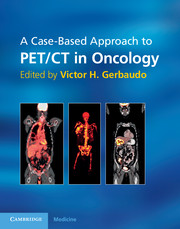Book contents
- Frontmatter
- Contents
- Contributors
- Foreword
- Preface
- Part I General concepts of PET and PET/CT imaging
- Part II Oncologic applications
- Chapter 5 Brain
- Chapter 6 Head, neck, and thyroid
- Chapter 7 Lung and pleura
- Chapter 8 Esophagus
- Chapter 9 Gastrointestinal tract
- Chapter 10 Pancreas and liver
- Chapter 11 Breast
- Chapter 12 Cervix, uterus, and ovary
- Chapter 13 Lymphoma
- Chapter 14 Melanoma
- Chapter 15 Bone
- Chapter 16 Pediatric oncology
- Chapter 17 Malignancy of unknown origin
- Chapter 18 Sarcoma
- Chapter 19 Methodological aspects of therapeutic response evaluation with FDG-PET
- Chapter 20 FDG-PET/CT-guided interventional procedures in oncologic diagnosis
- Index
- References
Chapter 18 - Sarcoma
from Part II - Oncologic applications
Published online by Cambridge University Press: 05 September 2012
- Frontmatter
- Contents
- Contributors
- Foreword
- Preface
- Part I General concepts of PET and PET/CT imaging
- Part II Oncologic applications
- Chapter 5 Brain
- Chapter 6 Head, neck, and thyroid
- Chapter 7 Lung and pleura
- Chapter 8 Esophagus
- Chapter 9 Gastrointestinal tract
- Chapter 10 Pancreas and liver
- Chapter 11 Breast
- Chapter 12 Cervix, uterus, and ovary
- Chapter 13 Lymphoma
- Chapter 14 Melanoma
- Chapter 15 Bone
- Chapter 16 Pediatric oncology
- Chapter 17 Malignancy of unknown origin
- Chapter 18 Sarcoma
- Chapter 19 Methodological aspects of therapeutic response evaluation with FDG-PET
- Chapter 20 FDG-PET/CT-guided interventional procedures in oncologic diagnosis
- Index
- References
Summary
Sarcomas are solid malignant tumors arising from mesenchymal tissue with distinct clinical and pathological features. They constitute a diverse group of tumors with more than 50 different histological subtypes divided into two broad categories: sarcomas of soft tissues (including fat, muscles, nerves, blood vessels, and other connective tissues) and sarcomas of bones (1, 2). Several classification schemes for sarcoma exist. In general, classification is based on histology with tumors subdivided according to the presumed tissue of origin.
Sarcomas can occur anywhere in the body and at all ages in both men and women. The age of incidence depends, at least in part, on the type as well as the subtype. For example, osteosarcomas tend to develop in young adults while chondrosarcomas are more common in older patients. Sarcomas found within certain organs may be difficult to differentiate from other malignancies; therefore, the true incidence of sarcomas is likely underestimated (3). Collectively, sarcomas are believed to account for approximately 1% of all adult malignancies and 15% of all pediatric malignancies (1). While soft tissue sarcomas are overall more frequent in middle-aged and older adults than in children and young adults, some subtypes such as rhabdomyosarcoma and synovial sarcoma are more common in young patients. Indeed soft tissue sarcomas account for a large proportion of pediatric malignancies, i.e., 7–10%. The incidence of primary bone tumors is approximately one-fifth that of soft tissue sarcomas. However, primary bone tumors also represent a significant percentage of malignancies in patients under the age of 20. Sarcomas are an important cause of death in the 14–29 years age group (4). Even in adults, the number of years of life lost is substantial despite the very low incidence of the disease, because people are often affected during the prime of their life (3).
Information
- Type
- Chapter
- Information
- A Case-Based Approach to PET/CT in Oncology , pp. 466 - 486Publisher: Cambridge University PressPrint publication year: 2012
